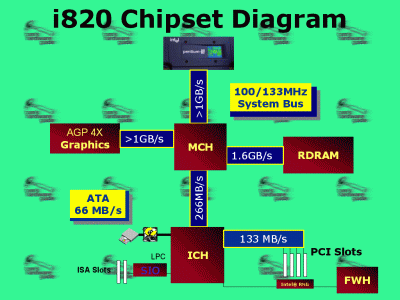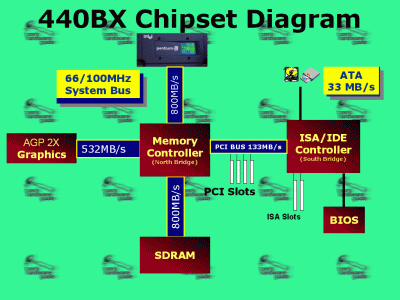Intel i820 Chipset Review (original) (raw)
Page 1 of 12:
Introduction
Introduction
The long anticipated 'Camino' or i820 Chipset still isn't released! Intel's first target was for June 99 and then was pushed forward to September 99. Just days before Intel's planned launch, September 27, 1999, an issue with memory data integrity when more than 2 banks of RDRAM are installed puts a quick stop to the products launch. Tom did the first preview of the i820 chipset set back in June, Preview of Intel's Upcoming 'Camino'-Chipset . Intel was so kind to provide me with a newer sample of the chipset on their VC820 i820 based motherboard. To make my testing more interesting, I've included Intel's tried-and-true 440BX and VIA's Apollo Pro 133 chipsets into my comparison. Given the new features provided by the i820 chipset, I did my best to try and extract the performance benefits each feature has to offer.
What Does The I820 Bring To The Table?
The i820 includes several new features that were implemented to increase bandwidth across the platform. Here is my list of the most important features implemented into the i820 chipset.
Swipe to scroll horizontally
| Feature | Advantage | Notes |
|---|---|---|
| AGP 4X | Provides >1 GB/s bandwidth vs. AGP 2X's 532 MB/s | From previous experiences, from 1X to 2X AGP didn't provide much of a performance boost. However, with AGP 4x new games can supply much more detail in terms of polygon count and texture size, and today the new and upcoming 3D-hardware can process it. Thus AGP4x should make a much bigger difference than AGP2x did over AGP1x or PCI. |
| 133 MHz FSB | Provides a 33% faster bus speed for both the memory and CPU. | Effect on CPU performance will be minimal due to the high speed L2 cache in the majority of applications. Video processing and voice recognition software as well as other memory intensive applications may have a higher chance of benefiting from the 33% in memory bandwidth though. |
| RDRAM or Rambus memory | Provides twice the memory bandwidth vs. PC-100, a requirement for the increased AGP bus speed | CPU can only take advantage of 33% more memory bandwidth due to the increase in bus speed and we should also not forget that RDRAM has a higher latency than SDRAM. Thus software with lots of random accesses to memory will actually run slower with RDRAM than with SDRAM. |
| UDMA66 | Provides twice the bandwidth to ATA66 peripherals vs. ATA33. | In non-raid configurations (striping, etc..) today's ATA devices have limited sustained transfer rates |
| New HUB Architecture | Removes the slow PCI bus (133 MB/s) as the bottleneck to I/O devices. | Instead of the North and South bridge communicating through the PCI bus they now have double the bandwidth at 266 MB/s |
| AMR(Audio/Modem Riser) | Requires only an external modem/audio-codec which won't cost much more than 10 bucks, to offer sound as well as a 56k-modem | This soft modem/audio robs relies on CPU bandwidth, thus robbing precious CPU cycles. |
HUB Architecture
The i820 is based on the same HUB architecture as the already shipping, low-end i810 chipset. Basically these two chipsets architecture's are identical except the i820 has a 4X AGP bus (without video integration), 133 MHz FSB capability, and RDRAM support. We did two comprehensive reports on the i810 chipset in April 99: Whitney, Intel's 810 Chipset - Part I and Whitney, Intel's 810 Chipset - Part II . To assist in clarifying the new HUB architecture of the i820, I've included a diagram for it and the North / South Bridge based i440BX chipset. As they say: "Pictures are worth a thousand words."

These diagrams demonstrate the i820's advantage with its new architecture. Due to the MCH having direct access to the memory bus, the slow PCI bus does not limit the i820. The i820's UDMA66 support provides twice the bandwidth as the 440BX's UDMA33. However, even the fastest ATA-66 drives can only sustain ~13 MB/s transfer rates.

Get Tom's Hardware's best news and in-depth reviews, straight to your inbox.